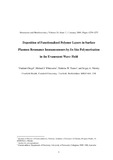- CERES Home
- →
- Cranfield Health
- →
- Staff publications - Cranfield Health
- →
- View Item
JavaScript is disabled for your browser. Some features of this site may not work without it.
| dc.contributor.author | Chegel, Vladimir | - |
| dc.contributor.author | Whitcombe, Michael J. | - |
| dc.contributor.author | Turner, Nicholas W. | - |
| dc.contributor.author | Piletsky, Sergey A. | - |
| dc.date.accessioned | 2011-10-11T07:55:33Z | |
| dc.date.available | 2011-10-11T07:55:33Z | |
| dc.date.issued | 2009-01-01T00:00:00Z | - |
| dc.identifier.citation | Vladimir Chegel, Michael J. Whitcombe, Nicholas W. Turner, Sergey A. Piletsky, Deposition of functionalized polymer layers in surface plasmon resonance immunosensors by in-situ polymerization in the evanescent wave field, Biosensors and Bioelectronics, Volume 24, Issue 5, 1 January 2009, Pages 1270-1275. Selected Papers from the Tenth World Congress on Biosensors Shangai, China, May 14-16, 2008 | - |
| dc.identifier.issn | 0956-5663 | - |
| dc.identifier.uri | http://dx.doi.org/10.1016/j.bios.2008.07.059 | - |
| dc.identifier.uri | http://dspace.lib.cranfield.ac.uk/handle/1826/4394 | |
| dc.description.abstract | Traditionally, the integration of sensing gel layers in surface plasmon resonance (SPR) is achieved via “bulk” methods, such as precipitation, spin- coating or in-situ polymerization onto the total surface of the sensor chip, combined with covalent attachment of the antibody or receptor to the gel surface. This is wasteful in terms of materials as the sensing only occurs at the point of resonance interrogated by the laser. By isolating the sensing materials (antibodies, enzymes, aptamers, polymers, MIPs, etc.) to this exact spot a more efficient use of these recognition elements will be achieved. Here we present a method for the in-situ formation of polymers, using the energy of the evanescent wave field on the surface of an SPR device, specifically localized at the point of interrogation. Using the photo-initiator couple of methylene blue (sensitizing dye) and sodium p-toluenesulfinate (reducing agent) we polymerized a mixture of N,N-methylene-bis-acrylamide and methacrylic acid in water at the focal point of SPR. No polymerization was seen in solution or at any other sites on the sensor surface. Varying parameters such as monomer concentration and exposure time allowed precise control over the polymer thickness (from 20–200 nm). Standard coupling with 1-ethyl-3-(3- dimethylaminopropyl)carbodiimide and N-hydroxysuccinimide was used for the immobilization of protein G which was used to bind IgG in a typical biosensor format. This model system demonstrated the characteristic performance for this type of immunosensor, validating our deposition m | en_UK |
| dc.language.iso | en_UK | - |
| dc.publisher | Elsevier Science B.V., Amsterdam. | en_UK |
| dc.subject | In-situ polymerization | en_UK |
| dc.subject | Photopolymerization | en_UK |
| dc.subject | Surface plasmon resonance | en_UK |
| dc.subject | Immunosensor | en_UK |
| dc.subject | Functional polymer | en_UK |
| dc.title | Deposition of functionalized polymer layers in surface plasmon resonance immunosensors by in-situ polymerization in the evanescent wave field | en_UK |
| dc.type | Article | - |
